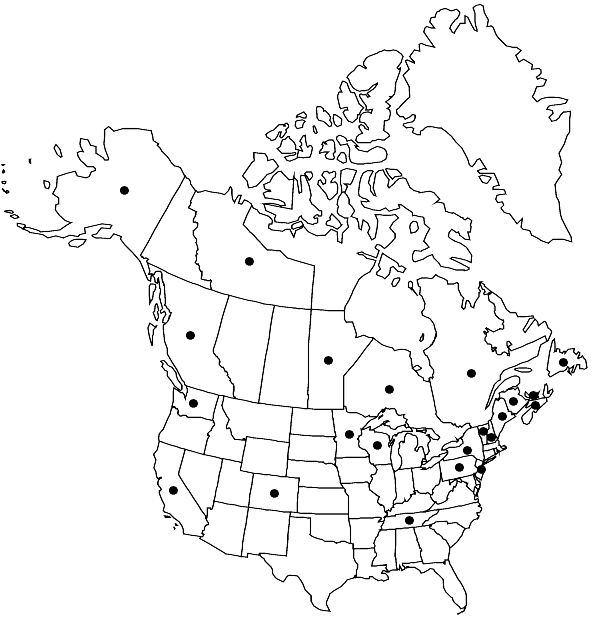Difference between revisions of "Polytrichastrum formosum"
Mem. New York Bot. Gard. 21(3): 37. 1971,.
FNA>Volume Importer |
FNA>Volume Importer |
(No difference)
| |
Revision as of 19:37, 24 September 2019
Plants medium and slender to large and robust, green to dark olive green to blackish, in loose tufts. Stems (2–)3–8(–20) cm, mostly unbranched. Leaves 6–8(–12) mm, erect to erect-spreading when dry, spreading to subsquarrose and broadly recurved when moist; sheath ovate to elliptic, yellowish, hyaline-margined, gradually tapering or abruptly contracted to the blade, the cells at the shoulders forming a differentiated hinge; blade lanceolate to linear; costa prominent abaxially and toothed near the tip; excurrent as a short, toothed point; marginal lamina erect, (2–)3–5(–10) cells wide, plane or erect, sharply toothed from apex nearly to the sheath; lamellae (3–)4–5(–7) cells high, margins ± entire to finely serrulate in profile, the marginal cells in section rounded to narrowly elliptic and somewhat taller than the cells beneath, the cell walls not or moderately thickened; median cells of sheath 8–12 µm wide, narrowly rectangular, 5–7(–10):1; cells of marginal lamina subquadrate, 10–15 µm. Sexual condition dioicous or polygamous; perichaetial leaves similar to the foliage leaves, or somewhat longer, with a longer sheath. Seta 3–6 cm, yellowish to reddish brown. Capsule 4–7 mm, rather slender or short-rectangular, acutely 4(–6)-angled, inclined to almost horizontal, pale yellowish brown to brownish; hypophysis cylindric, indistinctly delimited or set off by a shallow groove; exothecium smooth or the cells weakly convex, quadrate to hexagonal, without a central thin spot; peristome 600 µm, divided to 0.6, the teeth 64 and highly regular in form or fewer and somewhat irregular, pale to brownish; epiphragm absent marginal teeth. Spores 12–16 µm.
Distribution

Widespread, temperate to cool temperate latitudes in the Northern Hemisphere.
Discussion
Varieties 3 (2 in the flora).
European treatments often assert a similarity between Polytrichastrum formosum and Polytrichum commune, which cannot be said of the North American expression of the species. The habitat and ecology of the European plants are also distinct: A. J. E. Smith (2004) described P. formosum in Britain as a common and weedy species of heaths, moorland, woods, outcrops, and old walls.
Selected References
None.
Key
| 1 | Plants often robust, 5-10(-20) cm; leaves subsquarrose and broadly spreading- recurved when moist; lamellae 5-7 cells high, entire, the marginal cells in section rounded, moderately thick-walled; capsule short rectangular; hypophysis delimited by a shallow groove; peristome teeth 64, regular in form; dioicous | Polytrichastrum formosum var. formosum |
| 1 | Plants rather slender, 3-6(-10) cm; leaves spreading when moist; lamellae (3-)4-6 cells high, the marginal cells narrowly elliptic, not or only slightly thickened; capsule slender; hypophysis not sharply delimited; peristome teeth 50-64, somewhat irregular in size and shape; monoicous (polyga- mous) | Polytrichastrum formosum var. densifolium |